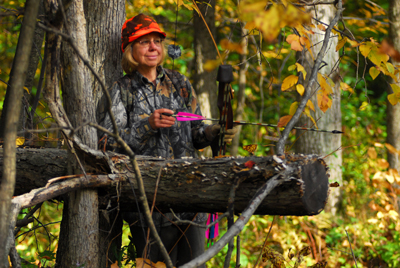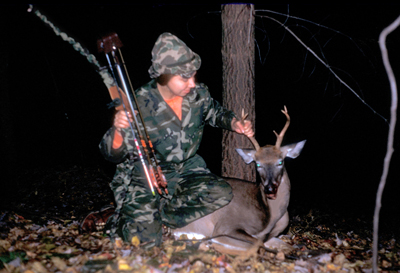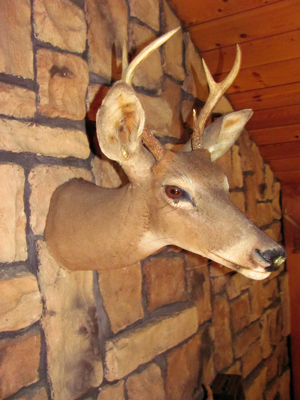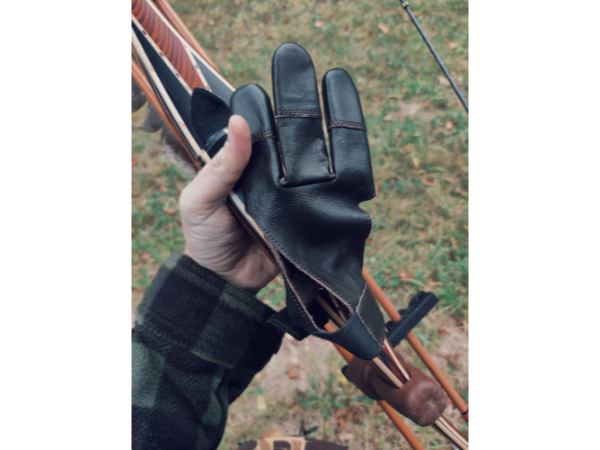“Why do we keep driving to the top of the mountain?” my husband and hunting buddy Bob asked.
“I don’t know,” I answered. “Look at all these muddy deer trails coming off the bank right along the hard road.”
Our drives every day from our campground in north-central Pennsylvania’s Little Pine Creek valley, up the dirt roads in the state forest until we got to the mountain top, had so far left us deer-less. Yes, there was some deer sign up there, but acorns were spotty and the ridges were covered with mountain laurel, where there weren’t ferns and oak.

Linda bowhunts the forests in her home state of Pennsylvania with her husband, Bob.
A friend once gave us sage advice about fishing. The number-one rule, he said, is “Fish where the fish are.” Their deeply worn trails along the macadam road were telling us where the deer were.
So, we stopped the car and turned around, looking for places where we might take a stand with our bows. I was a newcomer to bowhunting then, still looking for my first deer with my Redwing Hunter recurve. Now, nearly 50 years later, I’ve had my share of tags filled, but I still remember what the deer taught me that day about bowhunting—how to hunt and get a shot—and about themselves.
“Why are the trails here?” Bob wondered aloud. The paths plummeted off a steep bank from mixed hemlocks and hardwoods above. The answer lay on the other side of the road. The hillside beyond the guard rail fell to the creek just upstream of where it flowed into a lake. Downstream, the lake blocked the deer’s access to the ridge opposite.
This was the first place for the length of the lake that deer could cross the valley. Maybe the oaks on the other side had more acorns, but there was also succulent greenery that edged the upper end of the impoundment for some distance. This was a farming valley long ago, and the deer may have relished the nutrients in the bottomland. Plus, we knew old apple trees were scattered in the valley. Perhaps they had born fruit.
“Up there, that could be a spot for you,” Bob said. As he already had some archery deer to his credit, as well as whitetails taken in gun seasons, I deferred to his judgment when selecting hunting stands. We parked and climbed the bank to assess the terrain. That’s when I spotted the buck rubs.
“Good eye!” he said. “No sense in going farther up the hill.”
I agreed. The deer were funneling to the trail here. If I went too far uphill, I might miss them or spook them going in.
We found a place not far from the road for me to take a ground stand. I’m good at shooting from my knees and petite enough that when I crouch down, I’m hard to see. I could sit on a log beside an upturned root, with a boulder and a big hemlock trunk to shield my motion. This would still give me an open arrow route to the trail. The skinned saplings told us that not just does passed by.
My position put me downwind of the trail, a necessity for the close shooting I’d have if any deer showed up. Not only was the prevailing wind from the west, but the cooling evening air would slip down-slope toward me. I cleared some twigs and crisp fallen leaves from my stand area, and we returned to the campsite for lunch and to shoot practice arrows before the afternoon hunt.
Then it was time. The road along the lake was in shadow already, with the late afternoon sun dropping low in the west. The October day had been warm, but there on the east side of the mountain without sunshine, there was a chill in the air that spoke of deep fall and winter. As I took my bow from the car and began climbing the bank, I turned to wave to my husband, who would go farther up the road. He’d given me the best spot. “And no argument,” he’d said. “Just take it. I want you to have first crack. You saw the rubs. There are some bucks up there.”
The woods were quiet, even more hushed when the squirrels stopped moving. They had gone on up the hill from my position and I could imagine them tucked into ball-like leaf nests or hollow tree trunks for the night. It was long past the time when chipmunks are afoot when I heard a sound of a different sort above me on the slope.
Although nearly an hour of legal shooting time remained, under the hemlocks the day was darker than it should have been. I could only see about 30 yards above me, but that was far enough to pick out a white throat patch and ears moving toward me. And pale antlers.

The author with her first deer, a five-point buck, taken with a Red Wing Hunter back in 1975.
It wasn’t a big buck, a forkhorn or five-point, plenty legal in my home state at that time. My eyes didn’t linger on the antlers. I had work to do. I slid off the seat and onto my knees, bending low and forward. I held my bow and nocked an arrow horizontally, scant inches from the ground. I knew that my shadowed silhouette against the lighter opening below me—I was only about 20 yards from the road—would be minimal in that position.
I watched the buck walk very slowly and, as whitetails will, very cautiously down the hill. I had mentally calculated how close he would have to get for me to feel confident shooting, and that would be within 20 yards. I knew which landmarks, what trees or rocks, he’d have to pass on the trail to get there. And then he’d have to stop. I wouldn’t shoot him on the move.
The buck was still stepping closer when I saw another. Where the first buck had appeared, I again saw a white throat patch, ears, and pale antlers, only this time the antlers were bigger—higher and wider. He was staring at me, his eyes locked onto my face, I could tell his rack had four tines on each side. An eight-point. My eight-point? Was my first buck to be an eight-point with a bow?
Then the little green imp of greed lit on my shoulder and started whispering in my ear. But he (she?) wasn’t perched there long. I brushed temptation off and never looked again at the bigger buck. I’d weighed the percentages of success and they said to stay with the surer thing, the smaller buck. Now he was so near I could see it was a five-point and was about to pass behind the trunk of a big hemlock at ten yards or less. My chance.

Linda’s buck mount on her fireplace wall.
As the buck’s head disappeared from my view, which meant I would disappear from his view, I rose upright, still kneeling, and at the same time drew the bow. He may have seen the last bit of drawing motion or suddenly spotted the strange form before him, but that was lucky for me. He stopped and turned his head, but my gaze and aim were already locked on the sweet spot behind his front shoulder. The broadhead was away and the fletching appeared solid in his side when he bolted out the hillside.
Where the other buck went, I have no idea. I had eyes only for the deer I had hit. As I’d been taught, I took a mental note of where the buck was standing when I shot, which wasn’t hard because he was so close, and the last place I saw him before he disappeared. I expected either or both locations to reveal blood, hair, or kicked-up leaves to show his “flight path.”
I turned for the road, walking down carefully because now I felt rubber legged. I knew the drill—wait a half-hour or so and then trail. As dark was approaching, I knew that we could be trailing the next morning or with flashlights, and I wanted to find some sign to get us going the right way while there was still daylight. Bob should soon be out of the woods himself and picking me up, and we could search.
But none of that had to be done. Bob had left his stand early, and the car was already below me. He had the window rolled down and one arm out, motioning me forward.
“He’s down, I just drove past your buck,” he called. “He only ran 30 or 40 yards out the hillside and collapsed. Let’s go get him!”
Of course, lots of archers have first deer tales and to each of us that time is unique. But why I think such stories are worth telling, and not just because it’s satisfying to draw a memory up to the surface, are the bits and pieces along the way that took us to the good ending—the decisions, the happenstance, the right choices at the right time, the knowledge we had and the knowledge we got on the spot. The happiest outcome became possible because we paid attention to what the deer told us—and we hunted where they were.
Linda says her Redwing Hunter is long gone, but she still shoots a 47# recurve, a Striker Fastback. She has updated her camo, too. Linda and husband, Bob, a frequent contributor to TBM, enjoy seeing the mounts of their first bow bucks on their fireplace every day, her 5-point and his 6-point. They live in and continue to enjoy bowhunting in northern Pennsylvania.
Equipment Notes: For the 1975 hunt that gave Linda her first buck, she shot a 47# Redwing Hunter recurve and Bear broadheads on Easton Gamegetter aluminum shafts.







Leave A Comment